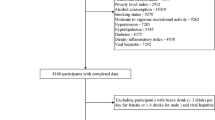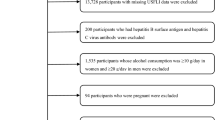Abstract
Background
Whether there is an association between dietary choline intake and non-alcoholic fatty liver disease (NAFLD) in American adults remains unclear.
Methods
Data came from the National Health and Nutrition Examination Survey 2017–2018. Choline intake was defined by the mean amounts of two 24 h dietary recalls, and choline intake was categorized into three groups according to the quartiles: inadequate (<P25), average (P25–P75), and optimal (>P75). Hepatic steatosis was assessed with FibroScan®, in which VCTE was employed with controlled attenuation to derive the controlled attenuation parameter (CAP), and NAFLD was defined as a CAP score ≥285 dB/m. Multivariable linear regression was performed to assess the linear relationship between choline intake and CAP. Multivariable logistics regression models were conducted to assess the association between choline intake status and NAFLD in the final sample and subgroup analysis was then performed in men and women.
Results
The amount of dietary choline was inversely associated with CAP score (β = −0.262, 95% CI: −0.280, −0.245). Compared to inadequate choline intake, optimal choline intake was related to a lower risk of NAFLD (OR: 0.705, 95% CI: 0.704–0.706) in the final sample. Subgroup analysis by gender revealed that the highest choline intake status was associated with a lower risk of NAFLD both in females (OR: 0.764, 95% CI: 0.762–0.766), and males (OR: 0.955, 95% CI: 0.953–0.958) when compared to the lowest choline intake.
Conclusions
With the latest NHANES data, we found that higher dietary choline was associated with a lower risk of NAFLD in American adults, and such a relationship exists in both females and males.
This is a preview of subscription content, access via your institution
Access options
Subscribe to this journal
Receive 12 print issues and online access
$259.00 per year
only $21.58 per issue
Buy this article
- Purchase on Springer Link
- Instant access to full article PDF
Prices may be subject to local taxes which are calculated during checkout

Similar content being viewed by others
Data availability
The NHANES dataset is publicly available online, accessible at cdc.gov/nchs/nhanes/index.htm (accessed on 8 March 2022).
References
Han E, Lee YH, Kim YD, Kim BK, Park JY, Kim DY, et al. Nonalcoholic fatty liver disease and sarcopenia are independently associated with cardiovascular risk. Am J Gastroenterol. 2020;115:584–95. https://doi.org/10.14309/ajg.0000000000000572.
Younossi Z, Anstee QM, Marietti M, Hardy T, Henry L, Eslam M, et al. Global burden of NAFLD and NASH: trends, predictions, risk factors and prevention. Nat Rev Gastroenterol Hepatol. 2018;15:11–20. https://doi.org/10.1038/nrgastro.2017.109.
Yki-Järvinen H. Non-alcoholic fatty liver disease as a cause and a consequence of metabolic syndrome. Lancet Diabetes Endocrinol. 2014;2:901–10. https://doi.org/10.1016/s2213-8587(14)70032-4.
Anania C, Perla FM, Olivero F, Pacifico L, Chiesa C. Mediterranean diet and nonalcoholic fatty liver disease. World J Gastroenterol. 2018;24:2083–94. https://doi.org/10.3748/wjg.v24.i19.2083.
Romero-Gómez M, Zelber-Sagi S, Trenell M. Treatment of NAFLD with diet, physical activity and exercise. J Hepatol. 2017;67:829–46. https://doi.org/10.1016/j.jhep.2017.05.016.
Heredia NI, Zhang X, Balakrishnan M, Daniel CR, Hwang JP, McNeill LH, et al. Physical activity and diet quality in relation to non-alcoholic fatty liver disease: a cross-sectional study in a representative sample of U.S. adults using NHANES 2017-8. Prev Med. 2022;154:106903. https://doi.org/10.1016/j.ypmed.2021.106903.
Yki-Järvinen H, Luukkonen PK, Hodson L, Moore JB. Dietary carbohydrates and fats in nonalcoholic fatty liver disease. Nat Rev Gastroenterol Hepatol. 2021;18:770–86. https://doi.org/10.1038/s41575-021-00472-y.
Christensen K, Lawler T, Mares J. Dietary carotenoids and non-alcoholic fatty liver disease among US adults, NHANES 2003–2014. Nutrients. 2019;11:1101. https://doi.org/10.3390/nu11051101.
Eliades M, Spyrou E, Agrawal N, Lazo M, Brancati FL, Potter JJ, et al. Meta-analysis: vitamin D and non-alcoholic fatty liver disease. Aliment Pharmacol Ther. 2013;38:246–54. https://doi.org/10.1111/apt.12377.
Zeisel SH, da Costa KA. Choline: an essential nutrient for public health. Nutr Rev. 2009;67:615–23. https://doi.org/10.1111/j.1753-4887.2009.00246.x.
Zeisel SH. Choline: critical role during fetal development and dietary requirements in adults. Annu Rev Nutr. 2006;26:229–50. https://doi.org/10.1146/annurev.nutr.26.061505.111156.
Canty DJ, Zeisel SH. Lecithin and choline in human health and disease. Nutr Rev. 1994;52:327–39. https://doi.org/10.1111/j.1753-4887.1994.tb01357.x.
Farrell G, Schattenberg JM, Leclercq I, Yeh MM, Goldin R, Teoh N, et al. Mouse models of nonalcoholic steatohepatitis: toward optimization of their relevance to human nonalcoholic steatohepatitis. Hepatology. 2019;69:2241–57. https://doi.org/10.1002/hep.30333.
Matthews DR, Li H, Zhou J, Li Q, Glaser S, Francis H, et al. Methionine- and choline-deficient diet-induced nonalcoholic steatohepatitis is associated with increased intestinal inflammation. Am J Pathol. 2021;191:1743–53. https://doi.org/10.1016/j.ajpath.2021.06.010.
Vesković M, Labudović-Borović M, Mladenović D, Jadžić J, Jorgačević B, Vukićević D, et al. Effect of betaine supplementation on liver tissue and ultrastructural changes in methionine-choline-deficient diet-induced NAFLD. Microsc Microanal. 2020;26:997–1006. https://doi.org/10.1017/s1431927620024265.
Yu D, Shu XO, Xiang YB, Li H, Yang G, Gao YT, et al. Higher dietary choline intake is associated with lower risk of nonalcoholic fatty liver in normal-weight Chinese women. J Nutr. 2014;144:2034–40. https://doi.org/10.3945/jn.114.197533.
Chang TY, Wu CH, Chang CY, Lee FJ, Wang BW, Doong JY, et al. Optimal dietary intake composition of choline and betaine is associated with minimized visceral obesity-related hepatic steatosis in a case-control study. Nutrients. 2022;14:261. https://doi.org/10.3390/nu14020261.
Guerrerio AL, Colvin RM, Schwartz AK, Molleston JP, Murray KF, Diehl A, et al. Choline intake in a large cohort of patients with nonalcoholic fatty liver disease. Am J Clin Nutr. 2012;95:892–900. https://doi.org/10.3945/ajcn.111.020156.
Chen YM, Liu Y, Zhou RF, Chen XL, Wang C, Tan XY, et al. Associations of gut-flora-dependent metabolite trimethylamine-N-oxide, betaine and choline with non-alcoholic fatty liver disease in adults. Sci Rep. 2016;6:19076. https://doi.org/10.1038/srep19076.
Fain JA. NHANES. Diabetes Educ. 2017;43:151. https://doi.org/10.1177/0145721717698651.
de Lédinghen V, Wong GL, Vergniol J, Chan HL, Hiriart JB, Chan AW, et al. Controlled attenuation parameter for the diagnosis of steatosis in non-alcoholic fatty liver disease. J Gastroenterol Hepatol. 2016;31:848–55. https://doi.org/10.1111/jgh.13219.
Myers RP, Pollett A, Kirsch R, Pomier-Layrargues G, Beaton M, Levstik M, et al. Controlled attenuation parameter (CAP): a noninvasive method for the detection of hepatic steatosis based on transient elastography. Liver Int. 2012;32:902–10. https://doi.org/10.1111/j.1478-3231.2012.02781.x.
Institute of Medicine Standing Committee on the Scientific Evaluation of Dietary Reference I, its Panel on Folate OBV, Choline. The National Academies Collection: Reports funded by National Institutes of Health. In: Dietary Reference Intakes for Thiamin, Riboflavin, Niacin, Vitamin B(6), Folate, Vitamin B(12), Pantothenic Acid, Biotin, and Choline. National Academies Press (US) Copyright © 1998, National Academy of Sciences: Washington (DC), 1998.
Wallace TC, Fulgoni VL 3rd. Assessment of total choline intakes in the United States. J Am Coll Nutr. 2016;35:108–12. https://doi.org/10.1080/07315724.2015.1080127.
Sherriff JL, O’Sullivan TA, Properzi C, Oddo JL, Adams LA. Choline, its potential role in nonalcoholic fatty liver disease, and the case for human and bacterial genes. Adv Nutr. 2016;7:5–13. https://doi.org/10.3945/an.114.007955.
Cheung O, Sanyal AJ. Recent advances in nonalcoholic fatty liver disease. Curr Opin Gastroenterol. 2010;26:202–8. https://doi.org/10.1097/MOG.0b013e328337b0c4.
Sivanesan S, Taylor A, Zhang J, Bakovic M. Betaine and choline improve lipid homeostasis in obesity by participation in mitochondrial oxidative demethylation. Front Nutr. 2018;5:61. https://doi.org/10.3389/fnut.2018.00061.
Chen J, Vitetta L. Gut microbiota metabolites in NAFLD pathogenesis and therapeutic implications. Int J Mol Sci. 2020;21:5214. https://doi.org/10.3390/ijms21155214.
Payne F, Lim K, Girousse A, Brown RJ, Kory N, Robbins A, et al. Mutations disrupting the Kennedy phosphatidylcholine pathway in humans with congenital lipodystrophy and fatty liver disease. Proc Natl Acad Sci USA 2014;111:8901–6. https://doi.org/10.1073/pnas.1408523111.
Walker AK, Jacobs RL, Watts JL, Rottiers V, Jiang K, Finnegan DM, et al. A conserved SREBP-1/phosphatidylcholine feedback circuit regulates lipogenesis in metazoans. Cell. 2011;147:840–52. https://doi.org/10.1016/j.cell.2011.09.045.
Vance DE. Role of phosphatidylcholine biosynthesis in the regulation of lipoprotein homeostasis. Curr Opin Lipidol. 2008;19:229–34. https://doi.org/10.1097/MOL.0b013e3282fee935.
Jacobs RL, van der Veen JN, Vance DE. Finding the balance: the role of S-adenosylmethionine and phosphatidylcholine metabolism in development of nonalcoholic fatty liver disease. Hepatol (Baltim, Md). 2013;58:1207–9. https://doi.org/10.1002/hep.26499.
Spencer MD, Hamp TJ, Reid RW, Fischer LM, Zeisel SH, Fodor AA. Association between composition of the human gastrointestinal microbiome and development of fatty liver with choline deficiency. Gastroenterology. 2011;140:976–86. https://doi.org/10.1053/j.gastro.2010.11.049.
Martínez-del Campo A, Bodea S, Hamer HA, Marks JA, Haiser HJ, Turnbaugh PJ, et al. Characterization and detection of a widely distributed gene cluster that predicts anaerobic choline utilization by human gut bacteria. mBio. 2015;6:e00042–15. https://doi.org/10.1128/mBio.00042-15.
Caballero F, Fernández A, Matías N, Martínez L, Fucho R, Elena M, et al. Specific contribution of methionine and choline in nutritional nonalcoholic steatohepatitis: impact on mitochondrial S-adenosyl-L-methionine and glutathione. J Biol Chem. 2010;285:18528–36. https://doi.org/10.1074/jbc.M109.099333.
Corbin KD, Zeisel SH. Choline metabolism provides novel insights into nonalcoholic fatty liver disease and its progression. Curr Opin Gastroenterol. 2012;28:159–65. https://doi.org/10.1097/MOG.0b013e32834e7b4b.
Dong H, Wang J, Li C, Hirose A, Nozaki Y, Takahashi M, et al. The phosphatidylethanolamine N-methyltransferase gene V175M single nucleotide polymorphism confers the susceptibility to NASH in Japanese population. J Hepatol. 2007;46:915–20. https://doi.org/10.1016/j.jhep.2006.12.012.
Song J, da Costa KA, Fischer LM, Kohlmeier M, Kwock L, Wang S, et al. Polymorphism of the PEMT gene and susceptibility to nonalcoholic fatty liver disease (NAFLD). FASEB J. 2005;19:1266–71. https://doi.org/10.1096/fj.04-3580com.
Author information
Authors and Affiliations
Contributions
CC: conceptualization, methodology, and writing - original draft; LC: data curation, formal analysis, and writing - review & editing; M-GD, YL, FL, and J-QN: writing - review & editing.
Corresponding author
Ethics declarations
Competing interests
The authors declare no competing interests.
Informed consent
Informed consent was obtained from all subjects involved in the study. Study details are available online at cdc.gov/nchs/nhanes/irba98.htm.
Additional information
Publisher’s note Springer Nature remains neutral with regard to jurisdictional claims in published maps and institutional affiliations.
Supplementary information
Rights and permissions
Springer Nature or its licensor (e.g. a society or other partner) holds exclusive rights to this article under a publishing agreement with the author(s) or other rightsholder(s); author self-archiving of the accepted manuscript version of this article is solely governed by the terms of such publishing agreement and applicable law.
About this article
Cite this article
Chai, C., Chen, L., Deng, MG. et al. Dietary choline intake and non-alcoholic fatty liver disease (NAFLD) in U.S. adults: National Health and Nutrition Examination Survey (NHANES) 2017–2018. Eur J Clin Nutr 77, 1160–1166 (2023). https://doi.org/10.1038/s41430-023-01336-1
Received:
Revised:
Accepted:
Published:
Issue Date:
DOI: https://doi.org/10.1038/s41430-023-01336-1



